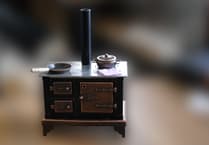AS A child of the 70s and 80s I still remember a time when the arrival of the post felt quite exciting.
You never knew what was going to appear in the pile of letters on the mat. Sometimes there was nothing much of interest – but every now and again a hand-written letter would arrive. Sometimes there were even stickers on the envelope! The familiar writing of a friend on the envelope would spark a moment of anticipation as to what interesting news might be inside. In any event it always felt nice for someone to have taken the time and trouble to write letter in the first place.
During summer holidays with my mother in Finland this excitement was even more pronounced. My Finnish relations lived on a small farm that was so remote that everyone would run to the window any time a car passed. The post box was about 500 metres away down a long, sandy track, so every day someone would be sent to see what had arrived.
On the days when this was my job, I was always very excited when I saw that there was a letter from my father back in England.
The inventor of Facebook had not even been born back then and it was far too expensive to think of using the landline to phone abroad – so receiving a letter felt very precious indeed.
I reflected the other day that it is years since I have had that feeling. Nowadays there are plenty of times when no post arrives at all, and when it does it is almost always made up of advertisements for double glazing, food delivery services or bills. None of which fill me with either excitement or joy.
I certainly don’t find myself running to the door when I hear the clink of the letter box.
With the advent of the internet and particularly social media it is hardly surprising that traditional letter-writing has gone out of fashion. However, in my opinion at least, it remains the most underrated and simple way to brighten up someone’s day. Unlike text messages and posts on Facebook, a letter is something tangible that you can hold in your hand, treasure and keep.
Of course, back in my youth the price of a first-class stamp was 3p – rising to 10p in 1979, so letter writing was not as much of a luxury as it is now. However the price of a stamp is still (just) under a pound – which is less than most people are prepared to pay for a coffee, so most of us are likely to be able to afford this at least from time to time.
Even as I write this I can hear how old I must be sounding to anyone reading these words. I do think though, that it can often be a very good thing to look back at the way things used to be done to see whether there is anything we can learn from that or even start to bring back into our modern-day lives.
For my own part, I bought a letter-writing set the other day and decided to write at least one letter a week for the rest of this year. I started off with a friend of mine who is now in her 80s and lives alone. I am fairly certain she will be both pleased and surprised when my first ever letter to her appears in her postbox. I am also secretly hoping that she takes the bait and decides to write back!
I have met some people who (apart from official communications) have never received a letter from a friend in their lives. This feels very sad to me. Whilst I would never suggest that we returned to days without the technology we have now – I do think there is much to be said for remembering someone using a pen, paper and envelope.
So to anyone not in the habit of writing letters, can I challenge you to give it a try? Think of someone who would love to hear from you and just put your thoughts down however they might appear. If writing feels a little alien, try talking to the person out loud as if they were there and just write down what you are saying.
It is not so much the content which will make the difference, but the time and effort you have gone to in order to put the letter together. In a world when people are often feeling lost and a bit isolated, receiving a letter from a friend is likely to be a sure-fire way to brighten up someone else’s day.





Comments
This article has no comments yet. Be the first to leave a comment.